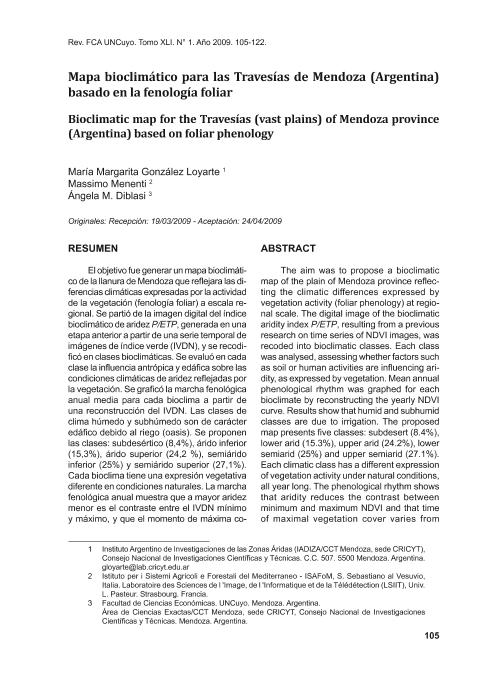Artículo
El objetivo fue generar un mapa bioclimático de la llanura de Mendoza que reflejara las diferencias climáticas expresadas por la actividad de la vegetación (fenología foliar) a escala regional. Se partió de la imagen digital del índice bioclimático de aridez P/ETP, generada en una etapa anterior a partir de una serie temporal de imágenes de índice verde (IVDN), y se recodificó en clases bioclimáticas. Se evaluó en cada clase la influencia antrópica y edáfica sobre las condiciones climáticas de aridez reflejadas por la vegetación. Se graficó la marcha fenológica anual media para cada bioclima a partir de una reconstrucción del IVDN. Las clases de clima húmedo y subhúmedo son de carácter edáfico debido al riego (oasis). Se proponen las clases: subdesértico (8,4%), árido inferior (15,3%), árido superior (24,2 %), semiárido inferior (25%) y semiárido superior (27,1%). Cada bioclima tiene una expresión vegetativa diferente en condiciones naturales. La marcha fenológica anual muestra que a mayor aridez menor es el contraste entre el IVDN mínimo y máximo, y que el momento de máxima co-bertura vegetal varía de enero (semiárido) a abril (subdesértico). Esta propuesta permite extender y optimizar el conocimiento climático de las estaciones meteorológicas a través de toda la llanura mediante la expresión fenológica de la vegetación. The aim was to propose a bioclimatic map of the plain of Mendoza province reflecting the climatic differences expressed by vegetation activity (foliar phenology) at regional scale. The digital image of the bioclimatic aridity index P/ETP, resulting from a previous research on time series of NDVI images, was recoded into bioclimatic classes. Each class was analysed, assessing whether factors such as soil or human activities are influencing aridity, as expressed by vegetation. Mean annual phenological rhythm was graphed for each bioclimate by reconstructing the yearly NDVI curve. Results show that humid and subhumid classes are due to irrigation. The proposed map presents five classes: subdesert (8.4%), lower arid (15.3%), upper arid (24.2%), lower semiarid (25%) and upper semiarid (27.1%). Each climatic class has a different expression of vegetation activity under natural conditions, all year long. The phenological rhythm shows that aridity reduces the contrast between minimum and maximum NDVI and that time of maximal vegetation cover varies from January, under semiarid climate, to April, in subdesert climate. This proposal allows enhancement and optimization of meteorological data throughout the whole plain by means of vegetation phenology.
Mapa bioclimático para las Travesías de Mendoza (Argentina) basado en la fenología foliar
Título:
Bioclimatic map for the Travesías (vast plains) of Mendoza province (Argentina) based on foliar phenology
Fecha de publicación:
06/2009
Editorial:
Universidad Nacional de Cuyo. Facultad de Ciencias Agrarias
Revista:
Revista de la Facultad de Ciencias Agrarias de la Universidad Nacional de Cuyo
ISSN:
0370-4661
e-ISSN:
1853-8665
Idioma:
Español
Tipo de recurso:
Artículo publicado
Clasificación temática:
Resumen
Archivos asociados
Licencia
Identificadores
Colecciones
Articulos(IADIZA)
Articulos de INST. ARG DE INVEST. DE LAS ZONAS ARIDAS
Articulos de INST. ARG DE INVEST. DE LAS ZONAS ARIDAS
Citación
Gonzalez Loyarte, Maria Margarita; Massimo Menenti; Diblasi, Angela Magdalena; Mapa bioclimático para las Travesías de Mendoza (Argentina) basado en la fenología foliar; Universidad Nacional de Cuyo. Facultad de Ciencias Agrarias; Revista de la Facultad de Ciencias Agrarias de la Universidad Nacional de Cuyo; XLI; 1; 6-2009; 105-122
Compartir




